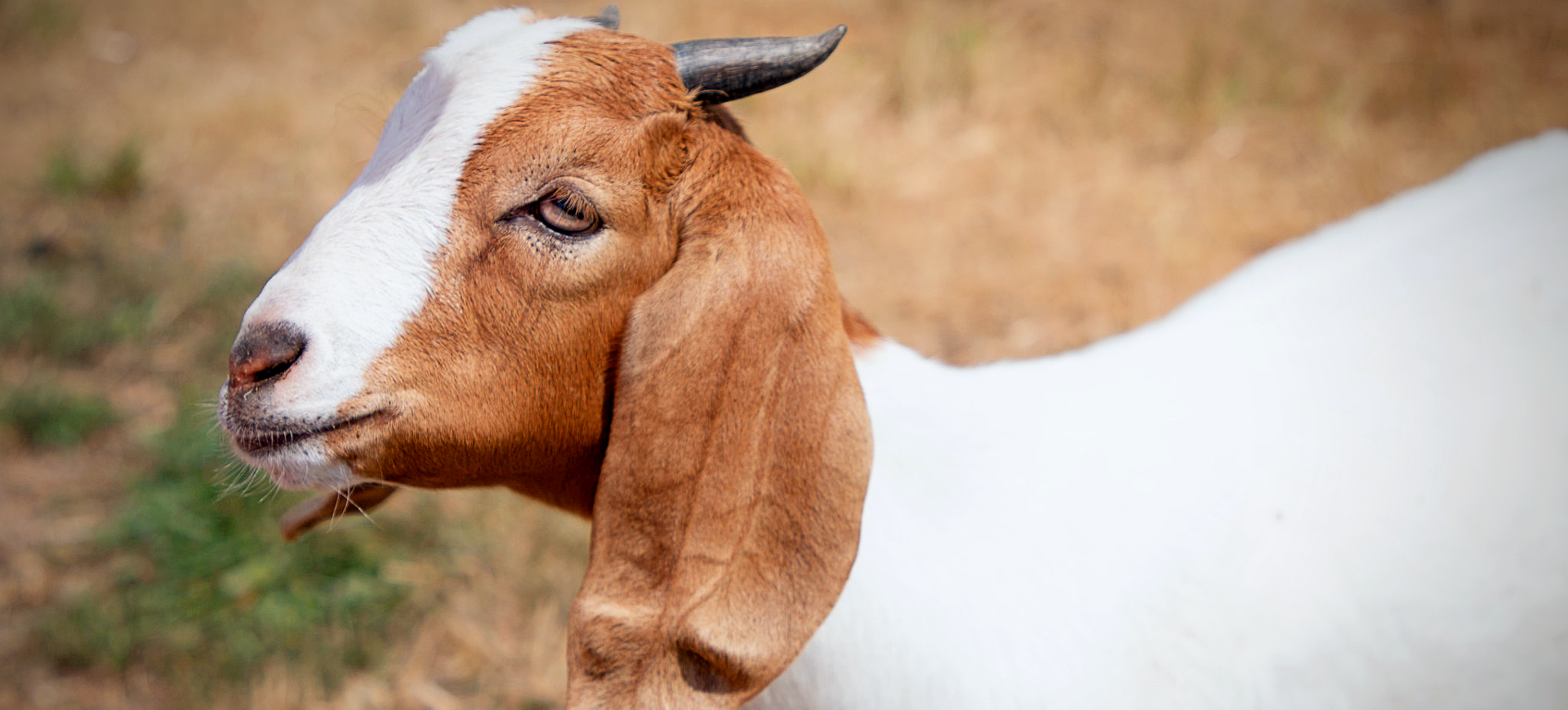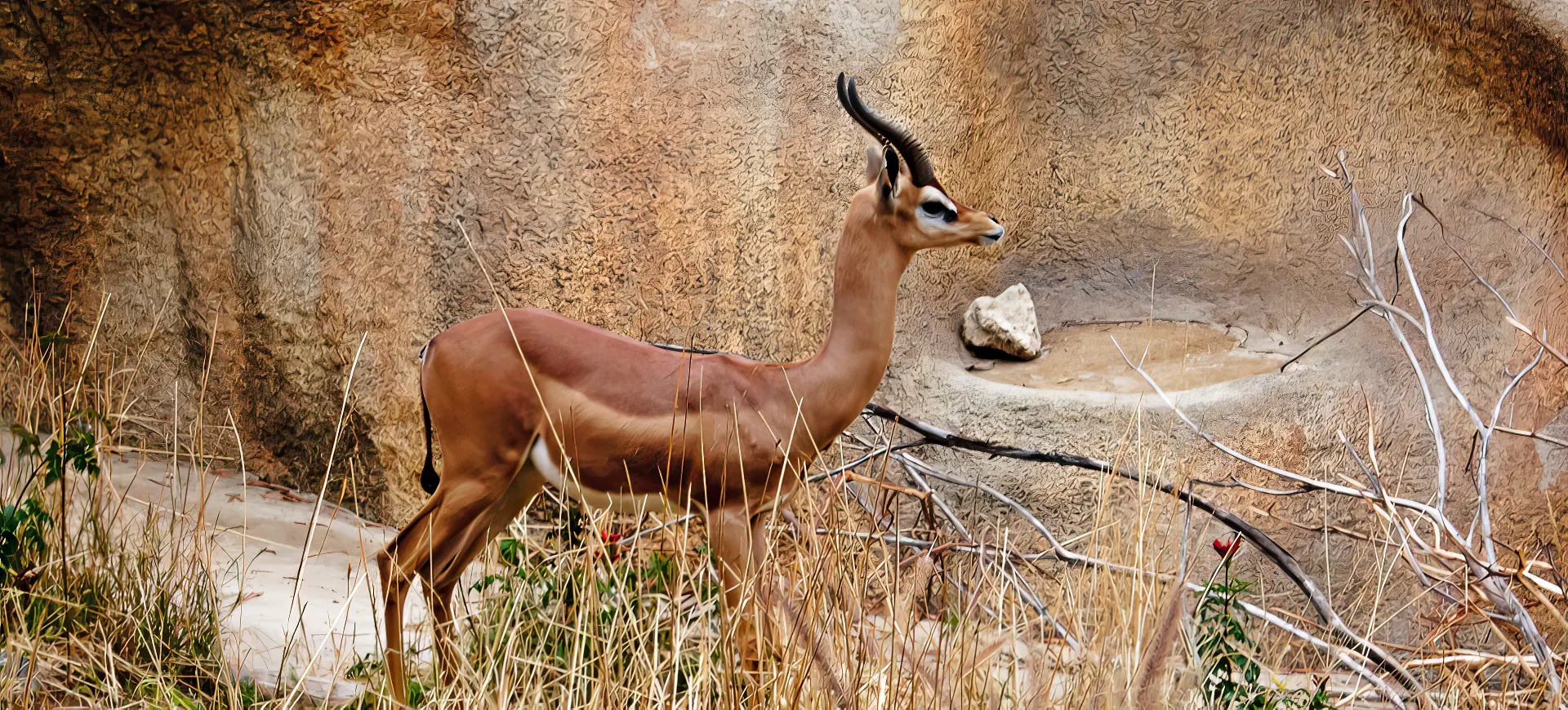Overview
Soemmerring’s Gazelle, scientifically named Nanger soemmerringii, is an elegant and swift antelope native to the Horn of Africa, encompassing parts of Ethiopia, Somalia, and Djibouti. This species is distinguished by its striking appearance, featuring a reddish-brown coat with distinctive white patches and a dark, lateral stripe that separates the upper parts from the white underbelly. Males and females possess ringed horns, though the males’ are thicker and longer, reaching up to 70 cm (27.5 inches) in length and characterized by their pronounced curvature.
These gazelles inhabit arid regions, including savannas, grasslands, and light woodlands, where they are adapted to living in a harsh environment with scarce water sources. Soemmerring’s Gazelles are highly social animals, forming groups ranging from small family units to larger herds of up to 100 individuals, especially outside the breeding season. They are predominantly diurnal, with peak activity periods at dawn and dusk during the cooler hours of the day, feeding on various grasses, leaves, and shoots.
The species plays a vital role in its ecosystem, serving as a key prey species for several predators, including lions, cheetahs, and hyenas. Despite their speed and agility, their main defenses against predators, Soemmerring’s Gazelles face threats from habitat loss, competition for resources with livestock, and hunting. Conservation efforts are underway to ensure the survival of this species, focusing on habitat protection and the establishment of protected areas.
Taxonomy
Kingdom
Phylum
Class
Order
Family
Genus
Species
Sub Species
Type
Physical Description:
Soemmerring’s Gazelle is notable for its graceful build and striking coloration, standing approximately 90 cm (35 inches) at the shoulder with an average weight ranging from 35 to 45 kg (77 to 99 lbs) for females and 45 to 65 kg (99 to 143 lbs) for males. Their coats are a beautiful reddish to golden brown on the back, with a sharp contrast provided by the white underparts and rump. A dark, sharply defined stripe runs along the side, separating the two colors. Both sexes bear horns, which, in males, are long, ringed, and curved backward and forward, while, in females, they are shorter and thinner.
The Gazelle’s long, slender legs and specialized hooves are adapted for speed and agility, enabling them to swiftly escape predators. Their large, dark eyes are surrounded by white patches, enhancing their vision by reflecting more light into the eye, which is crucial for spotting predators in the dim light of dawn and dusk. The tail is short and bushy, with a black tip, often flicked as a signal to other gazelles. The physical attributes of Soemmerring’s Gazelle, from their adaptive coloration to their agile build, are a testament to their evolutionary adaptations to the savannas and arid regions they inhabit.

Lifespan: Wild: ~10 years || Captivity: ~15 years

Weight: Male: 99-143 lbs (45-65 kg) || Female: 77-99 lbs (35-45 kg)

Length: Male & Female: 49-59 inches (125-150 cm)

Height: Male & Female: 35 in (90 cm) at the shoulder

Top Speed: 40 mph (64 km/h)
Characteristic:
Native Habitat:
Soemmerring’s Gazelle inhabits a range of arid and semi-arid environments across the Horn of Africa, including grasslands, savannas, and light woodlands. They are particularly adapted to areas with a mix of open landscapes for feeding and denser vegetation or rocky outcrops for shelter and protection from predators. The distribution of Soemmerring’s Gazelle reflects their preference for habitats that offer access to the varied vegetation they require for feeding and the strategic advantages these environments provide against predators.
The species’ habitat is characterized by extreme conditions, high temperatures, and limited water sources, underscoring the Gazelle’s remarkable adaptations to survive in such environments. Conservation of their habitat is crucial, as it supports not only Soemmerring’s Gazelles but also a wide array of biodiversity, highlighting the ecological importance of these regions.
Climate Zones:
Biomes:
Biogeographical Realms:
Continents:
Diet:
Diet & Feeding Habits:
Soemmerring’s Gazelle is primarily a browser. It feeds on various vegetation, including leaves, shoots, flowers, and occasionally grasses, adapting its diet to the seasonal food availability. Their feeding strategy allows them to exploit different types of vegetation, which helps them survive in the variable ecosystems of the Horn of Africa. They are known to stand on their hind legs to reach higher branches, demonstrating their adaptability and versatility in foraging.
During the dry season, when vegetation is scarce, Soemmerring’s Gazelles may travel considerable distances for food and water, showcasing their survival ability in arid conditions. They also consume soil or lick rocks to supplement their diet with minerals. This adaptability in feeding behavior ensures that they can maintain their nutritional intake even in the harshest conditions, contributing to their survival and reproductive success.
Mating Behavior:
Mating Description:
The mating system of Soemmerring’s Gazelle is characterized by territorial males that establish and defend territories to attract females. During the breeding season, males become more aggressive, using their horns in battles for dominance and the right to mate with receptive females. These territorial disputes are crucial for establishing a hierarchy and ensuring genetic diversity within populations.
Females give birth to one or occasionally two calves after a gestation period of about six months. Calves are born well-developed and can stand and run quickly after birth, a crucial adaptation that increases their chances of survival in predator-rich environments. The care provided by the mother, including hiding the calf in vegetation to protect it from predators, is vital during the early stages of life. The reproductive strategies of Soemmerring’s Gazelle, from territorial battles to maternal care, are finely tuned to their environment, ensuring the species’ continued survival.
Reproduction Season:
Birth Type:
Pregnancy Duration:
Female Name:
Male Name:
Baby Name:
Social Structure Description:
Soemmerring’s Gazelle exhibits a flexible social structure, forming groups that vary in size and composition depending on the season and environmental conditions. Outside the breeding season, they may form mixed-sex herds or smaller groups consisting of females and their offspring, while males may form bachelor groups or become solitary, defending territories. The social dynamics within these groups are complex, with individuals communicating through vocalizations, body postures, and visual signals.
Forming herds provides several advantages, including increased vigilance against predators and more efficient foraging. Males’ territorial behavior during the breeding season plays a crucial role in the species’ reproductive strategy, ensuring that only the strongest and most fit individuals mate. Understanding the social structure of Soemmerring’s Gazelle is essential for its conservation, as it influences its habitat requirements, behavior, and susceptibility to threats.
Groups:
Conservation Status:
Population Trend:
The IUCN considers the population of Soemmerring’s Gazelle Vulnerable, and a decreasing trend has been observed in recent years. This decline is attributed to habitat loss, competition with livestock for resources, and hunting. The fragmentation of their habitat has isolated populations, making them more vulnerable to environmental changes and reducing their genetic diversity.
Conservation efforts are focused on habitat protection and establishing wildlife corridors that connect fragmented populations, allowing for gene flow and enhancing the species’ resilience-poaching measures. Community-based conservation initiatives are also crucial for protecting Soemmerring’s Gazelle from illegal hunting. Ensuring the survival of this species requires a multifaceted approach that addresses the complex challenges they face in the wild.
Population Threats:
The primary threats to Soemmerring’s Gazelle include habitat loss due to agricultural expansion, human settlement, and infrastructure development. Competition for grazing land and water with domestic livestock exacerbates the challenge of finding sufficient resources to support their populations. Illegal hunting for meat and trophies is another significant threat, contributing to the decline in their numbers.
Climate change poses a long-term threat by potentially altering the ecosystems these gazelles inhabit, affecting the availability and distribution of food and water resources. Addressing these threats requires concerted conservation efforts that involve local communities, governments, and international organizations, aiming to protect and restore the habitats essential for the survival of Soemmerring’s Gazelle.
Conservation Efforts:
Conservation efforts for Soemmerring’s Gazelle include establishing protected areas that safeguard key habitats from degradation and encroachment. Initiatives to mitigate human-wildlife conflict, such as developing sustainable grazing practices and water management, are crucial for ensuring the coexistence of gazelles with local communities and livestock. Wildlife corridors that connect fragmented habitats are essential for maintaining genetic diversity and allowing for seasonal migrations.
Education and awareness programs play a key role in promoting the conservation of Soemmerring’s Gazelle, highlighting their ecological importance and the threats they face. International collaboration is also vital, as the species’ range spans multiple countries. Through these combined efforts, conservationists aim to halt the decline of Soemmerring’s Gazelle populations and ensure their future in the wild.
Additional Resources:
Fun Facts
- Soemmerring’s Gazelle can sprint up to 40 mph (64 km/h), ranking it among the fastest antelopes in its African habitat.
- This gazelle species honors the German scientist Samuel Thomas von Soemmerring through its name.
- Remarkably adapted to arid environments, Soemmerring’s Gazelle can survive without direct water sources, relying on plant moisture.
- With exceptional vision, Soemmerring’s Gazelle can detect predators from afar, enabling swift escapes.
- The social structures and herd dynamics of Soemmerring’s Gazelle are intricately complex, adapting fluidly to changing environmental conditions and potential threats.
- Conservation efforts aimed at protecting Soemmerring’s Gazelle concurrently support the survival and thriving of other species within the same ecosystems, highlighting its key role in biodiversity conservation.
- The Gazelle’s uniquely shaped horns serve dual purposes: as a defense mechanism against predators and as an integral part of their mating rituals and social structure.
- In local cultures across its range, Soemmerring’s Gazelle is celebrated as an emblem of elegance and skill, inspiring folklore and regional art.
- Groups, or herds, of Soemmerring’s Gazelle, vary significantly in size, reflecting the species’ adaptive responses to environmental stresses and predation risks.
- The conservation of Soemmerring’s Gazelle not only aids in preserving this species but also acts as a catalyst for broader ecological conservation initiatives within its habitat.














































































